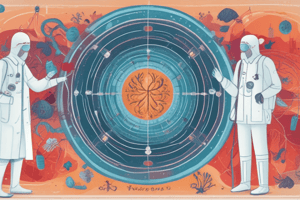Podcast
Questions and Answers
What characterizes an endemic disease within a specific geographic area?
What characterizes an endemic disease within a specific geographic area?
- It can only be transmitted between humans.
- It occurs sporadically without a consistent presence.
- It always leads to severe outbreaks and rapid spread.
- It is present at a constant rate in a defined population. (correct)
How is the basic reproduction number (R0) significant in understanding an outbreak?
How is the basic reproduction number (R0) significant in understanding an outbreak?
- If R0 is greater than 1, the outbreak is likely to continue. (correct)
- R0 quantifies the effectiveness of public health interventions.
- R0 indicates the number of cases that will not be reported.
- R0 is always less than 1 in determining disease severity.
What does the epidemic curve illustrate during an outbreak?
What does the epidemic curve illustrate during an outbreak?
- The timing and magnitude of the outbreak over a period. (correct)
- The historical data of all related diseases in the area.
- The immediate response of public health authorities.
- The specific pathogens responsible for the outbreak.
Which statement about zoonotic diseases is accurate?
Which statement about zoonotic diseases is accurate?
In the context of epidemic investigations, why is there a delay in reporting cases to health authorities?
In the context of epidemic investigations, why is there a delay in reporting cases to health authorities?
What is the ultimate goal of public health surveillance?
What is the ultimate goal of public health surveillance?
Which of the following is NOT a purpose of a surveillance system?
Which of the following is NOT a purpose of a surveillance system?
Which method is employed to protect portals of entry in the context of infectious disease control?
Which method is employed to protect portals of entry in the context of infectious disease control?
What distinguishes communicable diseases from other types of diseases?
What distinguishes communicable diseases from other types of diseases?
What type of data source requires medical practitioners to report certain infectious diseases?
What type of data source requires medical practitioners to report certain infectious diseases?
Which of the following statements is true regarding Koch's postulates?
Which of the following statements is true regarding Koch's postulates?
Which of the following best describes sentinel surveillance?
Which of the following best describes sentinel surveillance?
Which of the following organisms is classified as a fungus?
Which of the following organisms is classified as a fungus?
What is a limitation of Koch's postulates?
What is a limitation of Koch's postulates?
What is a primary benefit of measuring the burden of a disease through surveillance?
What is a primary benefit of measuring the burden of a disease through surveillance?
In the context of public health interventions, increasing host defenses includes which of these practices?
In the context of public health interventions, increasing host defenses includes which of these practices?
Which statement correctly describes bacteria?
Which statement correctly describes bacteria?
Which of the following statements accurately reflects public health actions related to antimicrobial resistance?
Which of the following statements accurately reflects public health actions related to antimicrobial resistance?
What type of organism includes both single-celled and multicellular forms?
What type of organism includes both single-celled and multicellular forms?
Which of the following best describes a parasite?
Which of the following best describes a parasite?
Which term is used interchangeably with communicable diseases?
Which term is used interchangeably with communicable diseases?
What is the primary composition of a virus?
What is the primary composition of a virus?
Which of the following best describes the mechanism by which prions induce disease?
Which of the following best describes the mechanism by which prions induce disease?
In direct contact transmission, how is the infectious agent primarily spread?
In direct contact transmission, how is the infectious agent primarily spread?
Which of the following is an example of vector-borne transmission?
Which of the following is an example of vector-borne transmission?
What does vehicle transmission involve?
What does vehicle transmission involve?
Which type of transmission can a respiratory virus utilize?
Which type of transmission can a respiratory virus utilize?
Which of the following statements regarding airborne transmission is true?
Which of the following statements regarding airborne transmission is true?
What characteristic distinguishes prions from viruses during transmission?
What characteristic distinguishes prions from viruses during transmission?
What is defined as fever >38ºC accompanied by cough or sore throat?
What is defined as fever >38ºC accompanied by cough or sore throat?
What is a limitation of using sentinel surveillance for influenza-like illness?
What is a limitation of using sentinel surveillance for influenza-like illness?
Which scenario best defines a disease outbreak?
Which scenario best defines a disease outbreak?
What distinguishes a pandemic from an epidemic?
What distinguishes a pandemic from an epidemic?
What is a more accurate method for determining the presence of influenza viruses?
What is a more accurate method for determining the presence of influenza viruses?
Which of the following best describes an epidemic?
Which of the following best describes an epidemic?
What role does sentinel surveillance play in public health?
What role does sentinel surveillance play in public health?
Which characteristic is NOT associated with a disease outbreak?
Which characteristic is NOT associated with a disease outbreak?
Flashcards
Microbiology
Microbiology
The study of microorganisms, which are typically small in size and simple in structure, not classified as plants or animals (except for parasites and algae).
Communicable Diseases
Communicable Diseases
Diseases that can spread from one person to another, or from animals to humans, either directly or indirectly.
Pathogenic Microorganisms
Pathogenic Microorganisms
Microorganisms capable of causing diseases in living organisms. Examples include bacteria, viruses, fungi, parasites, and prions.
Koch's Postulates
Koch's Postulates
Signup and view all the flashcards
Parasite
Parasite
Signup and view all the flashcards
Bacteria
Bacteria
Signup and view all the flashcards
Fungi
Fungi
Signup and view all the flashcards
Viruses
Viruses
Signup and view all the flashcards
What is public health surveillance?
What is public health surveillance?
Signup and view all the flashcards
What are the purposes of public health surveillance?
What are the purposes of public health surveillance?
Signup and view all the flashcards
What are the main data sources for public health surveillance?
What are the main data sources for public health surveillance?
Signup and view all the flashcards
What are statutory notifiable diseases?
What are statutory notifiable diseases?
Signup and view all the flashcards
What is sentinel surveillance?
What is sentinel surveillance?
Signup and view all the flashcards
What are the targets of public health intervention?
What are the targets of public health intervention?
Signup and view all the flashcards
How does public health intervention control infectious agents at the source?
How does public health intervention control infectious agents at the source?
Signup and view all the flashcards
What strategies are used to protect portals of entry in public health intervention?
What strategies are used to protect portals of entry in public health intervention?
Signup and view all the flashcards
What is a virus?
What is a virus?
Signup and view all the flashcards
What are prions?
What are prions?
Signup and view all the flashcards
What is direct contact transmission?
What is direct contact transmission?
Signup and view all the flashcards
What is droplet transmission?
What is droplet transmission?
Signup and view all the flashcards
What is airborne transmission?
What is airborne transmission?
Signup and view all the flashcards
What is vehicle transmission?
What is vehicle transmission?
Signup and view all the flashcards
What is vector-borne transmission?
What is vector-borne transmission?
Signup and view all the flashcards
Can an infection spread through multiple ways?
Can an infection spread through multiple ways?
Signup and view all the flashcards
Endemic
Endemic
Signup and view all the flashcards
Epidemic
Epidemic
Signup and view all the flashcards
Epidemic Curve
Epidemic Curve
Signup and view all the flashcards
Zoonosis
Zoonosis
Signup and view all the flashcards
Basic Reproduction Number (R0)
Basic Reproduction Number (R0)
Signup and view all the flashcards
Sentinel Surveillance for ILI
Sentinel Surveillance for ILI
Signup and view all the flashcards
Disease Outbreak
Disease Outbreak
Signup and view all the flashcards
Influenza Virus Detection Frequency
Influenza Virus Detection Frequency
Signup and view all the flashcards
Positive Influenza Virus Detection Percentage
Positive Influenza Virus Detection Percentage
Signup and view all the flashcards
Outbreak/ Epidemic
Outbreak/ Epidemic
Signup and view all the flashcards
Monitoring ILI Consultation Rate
Monitoring ILI Consultation Rate
Signup and view all the flashcards
Influenza Virus Detection
Influenza Virus Detection
Signup and view all the flashcards
Study Notes
Microbial Infections and Infectious Diseases
-
Summary of Injuries and Diseases:
- Types of Injury and Responses:
- Injurious stimulus types: altered physiological stimuli (e.g., increased demand, decreased stimulation), chronic irritation (physical/chemical), reduced oxygen supply, chemical injury, microbial infection.
- Cellular responses to injurious stimuli: Cellular adaptations (e.g., hyperplasia, hypertrophy, atrophy, metaplasia), cell injury (acute & transient, progressive & severe, including DNA damage), cumulative sublethal injury over long life span, metabolic alterations, genetic/acquired chronic injury, intracellular accumulations, calcification, cellular aging, and cell death (necrosis or apoptosis).
- Causes of Diseases:
- Vascular, inflammatory, neoplastic, degenerative, infectious, congenital, auto-immune, traumatic/toxic, environmental/endocrine.
- Types of Injury and Responses:
Introduction to Communicable Diseases
- Microbiology:
- The study of organisms (often small in size and simple in structure, excluding plants and animals except parasites and algae).
- Communicable Diseases:
- Spread directly or indirectly between people or from other species to humans
- Caused by pathogenic microorganisms (bacteria, viruses, fungi, parasites, or prions).
- Definition of an "infectious agent" using Koch's postulates (1876):
- Occurrence of the parasite in every case of the disease, absence in other cases
- Isolation from the body and pure culture of the parasite.
- Ability of the parasite to cause the disease when introduced to a susceptible host
- Re-isolation of the parasite from the experimental host that developed the disease.
Classification of Infectious Agents (Microbes)
-
Size, cell type, presence of nuclei, and tools for visualization are used to classify microbes.
-Helminths: Size from 1mm to 10 meters; eukaryotes with nuclei; visible with naked eye, magnifying glass, or light microscope. -Protozoa: Size from 2 µm to >100µm; eukaryotes with nuclei; typically viewed with a light microscope. -Fungi: Size from 3-10 µm (yeasts) to multicellular; eukaryotes with nuclei; often visualized with a light microscope. -Bacteria: Size from 0.5 µm to 5µm; prokaryotes (no nuclei); typically viewed using a light microscope. -Viruses: Size from 0.02 µm to 0.2 µm prokaryotes (no nuclei); often visualized using electron microscopy. -Prions: Size less than 1 nanometer, consist of proteins only; use molecular techniques for their visualization.
Disease Outbreaks and Epidemics
- Outbreak/Epidemic: Cases of an illness/event exceeding normal expectancy in a community or region.
- Pandemic: An epidemic extending through wide geographical boundaries, affecting a large number of people worldwide.
- Endemic: Constant presence of a disease/agent within a specific geographic area/population.
- Zoonosis: Diseases of animals that can be transmitted to humans.
- Epidemic: An increase in cases of disease above the usual or expected frequency within a certain population.
- Epidemic Curve: A graph showing the progression of disease cases over time, which can identify sources of outbreaks.
Anatomy of an Epidemic
- Identification of the progression, magnitude, size, time trend and spread patterns of an outbreak over time is essential. A graph plotting the number of cases by the date of illness onset.
Public Health Surveillance
- Public health surveillance: The ongoing, systematic process of collecting, interpreting, disseminating information about a health-related event for public health action to reduce morbidity and mortality.
- The purpose is to measure and monitor disease burden, investigate outbreaks, evaluate interventions or practices.
Host-Microbe Relationship
- Incubation Period: Time between exposure to a pathogen and the onset of symptoms.
- Prodromal Period: The onset of nonspecific, general symptoms following the incubation period.
- Illness Period: The period of prominent/specific symptoms and signs of an infectious disease.
- Decline Period: When symptoms start to resolve and decrease in severity.
- Convalescence: The recuperation phase after the symptoms decline.
Types of Infection
- Acute viral infection followed by viral clearance
- Acute viral infection followed by latent infection and periodic reactivation
- Acute viral infection followed by chronic infection
- Acute viral infection followed by a chronic infectious disease
Other Types of Infectious Agents
- Defective viruses: Viruses that lack all the proteins needed to replicate, meaning they rely on another virus type to replicate.
- Prions: Infectious proteins that cause other proteins to fold incorrectly.
Medically Important Gram-Positive Bacteria
- Gram-positive bacteria: Includes aerobic & anaerobic spore-forming species, and non-spore-forming species.
Medically Important Gram-Positive Cocci
- Gram-positive cocci, some species are highly pathogenic, some are not.
Pathogenic Neisseriae
- Gram-negative diplococci; oxidase-positive bacteria that cause disease and have specific virulence factors
Medically Important Gram-Positive Bacilli
- Gram-positive bacilli: Bacteria are rod-shaped, some are spores; various infections result from this group
Introduction to Fungi
- Fungi (Mycetology): Eukaryotes, contain β-1,6-Glucans, β-1,3-Glucan & Chitin in their cell walls, ergosterol in cell membrane, and have a distinct cellular structure.
Fungal Infections and Disease
- Superficial infections: Candidiasis (oral or vaginal thrush), dermatophytosis (Ringworm) → infections on surface of the body.
- Systemic Infections: Fungal infections that have spread throughout the body, affecting multiple organs (common in immunocompromised patients).
- Other (less common): Mycetoma → fungal disease, occurring locally or regionally.
Treatment of Fungal Infections
- Antifungal agents – various methods for targeting different cellular and metabolic processes in fungi: -Polyenes: interfere with plasma membrane -Azoles: inhibit ergosterol synthesis -Nucleoside analogues: inhibit some fungal components (e.g., 5-fluorocytosine) -Echinocandins: impede cell wall synthesis.
Introduction to Parasites
- Parasites are organisms that live on or in a host organism, deriving benefit from it, and often causing harm
- Protozoa: Unicellular parasitic microorganisms with diverse life cycles and clinical importance.
- Helminths: Multicellular parasitic worms (Nematodes, Trematodes, Cestodes) often involve intermediate hosts for transmission.
- Arthropods: Insects and arachnids which can act as vectors for other pathogens or cause direct harm.
Malaria
- Plasmodium spp.: Five parasite species that cause malaria in humans (vivax, falciparum, malariae, ovale, knowlesi).
- Transmission: Vector (female Anopheles mosquitoes) transmitted via saliva.
Important Medical Viruses
- Coronaviruses: Large group of viruses that cause various infections, including but not limited to some types of the common cold and significant diseases like SARS, MERS, COVID-19.
- Herpesviruses: Enveloped ds DNA viruses. HSV-1 & HSV-2, VZV/Varicella-Zoster (cold sores/shingles), CMV, EBV.
- Enteroviruses: Diverse group of small, non-enveloped, ssRNA viruses. Common cold-like symptoms in respiratory tract, but also affects various other body systems.
- Japanese Encephalitis (JE): Enveloped, + ssRNA. Severe encephalitis, but most infections are asymptomatic.
Other Infectious Agents
- Not all viruses are capable of replication independently; some rely on other viruses to complete their infectious cycles, while others rely on eukaryotic hosts. Prions are misfolded proteins that act as infectious agents.
Studying That Suits You
Use AI to generate personalized quizzes and flashcards to suit your learning preferences.




